Top 5 Guitar DAWs for Music Production Explained
Category: Guitar Gear
Discover the Best Guitar DAWs for Perfect Music Production
If you're a guitarist eager to elevate your music production workflow, choosing the right Digital Audio Workstation (DAW) can be daunting. Whether you're just stepping into recording your riffs or you’re an experienced musician seeking seamless integration with guitar gear and effects, this guide is tailored for you. You’ve likely searched for the "top guitar DAWs" to find tools that not only capture your playing’s nuances but also offer flexible recording, editing, and mixing capabilities specific to guitarists.
This post cuts through the clutter by focusing on the top 5 DAWs that cater not just to generic music production but to the intricate demands of guitar players—from tone shaping and effects processing to guitar-friendly interfaces and workflow. We dive into each DAW's strengths, user interface, plugin compatibility, and guitar-centric features, helping you make an informed choice fast. Unlike generic lists, our review aligns with your passion for guitar tones, gear, and techniques, ensuring each DAW supports your style and creative vision. Read on to find which DAW will truly resonate with your guitar journey and music production goals.
- Discover the Best Guitar DAWs for Perfect Music Production
- Overview of What Makes a DAW Great for Guitarists
- DAW #1: Ableton Live – Strengths in Live Looping, Guitar-Friendly Plugins, and Workflow Tips for Guitarists
- DAW #2: Logic Pro X – Deep Guitar Amp Sims, Seamless macOS Integration, and Comprehensive Production Tools
- DAW #3: Pro Tools – Industry-Standard Recording, Editing Precision, and Compatibility with Pro Guitar Hardware
- DAW #4: Reaper – Highly Customizable, Lightweight, Affordable, and Great Routing Options for Guitar Effects
- DAW #5: Cubase – Advanced Guitar Tracking Features, Chord Tools, and Native Guitar Effects Plugins
- Comparing Key Features Among Top Guitar DAWs – UI, Plugins, Guitar Amp Sims, MIDI Support, and Price
- How to Choose the Right DAW Based on Your Guitar Playing Style and Production Needs
- Tips for Optimizing Your DAW Setup for Guitar Recording and Effects Processing
- Integrating External Guitar Gear with Your DAW – Interfaces, Effects Pedals, and Amp Simulation
- Future Trends in Guitar-Focused DAWs and What Guitarists Should Watch For
- 1. Enhanced Artificial Intelligence (AI) and Machine Learning Integration
- 2. Native Support for Guitar-to-MIDI and Extended Hybrid Workflows
- 3. Advanced Real-Time Collaboration Features and Cloud Integration
- 4. Improved Hardware Integration and Smart Effects Automation
- 5. Immersive Audio and Spatial Effects Tailored for Guitarists
Overview of What Makes a DAW Great for Guitarists
When it comes to selecting a Digital Audio Workstation (DAW) tailored for guitarists, not all software is created equal. The ideal DAW for guitar players should combine practical features, seamless guitar integration, and intuitive ease of use to enhance both the creative process and technical workflow. Guitarists need more than just basic recording capabilities—they require DAWs equipped with specialized tools that capture the nuances of pick attack, expression, and tone shaping.
Key elements that define a great guitar DAW include:
-
Robust Guitar Input and Amp Simulation Support
Native compatibility with audio interfaces, low-latency monitoring, and built-in amp simulators or smooth third-party plugin integration allow guitarists to monitor and record with authentic tones and effects in real time. -
Intuitive Recording and Editing Workflow
Features like seamless punch-in/out, tempo-synced loop recording, and flexible comping help guitarists lock in performances efficiently without interrupting their creative flow. -
Comprehensive Effects and Plugin Compatibility
Access to a wide array of guitar-centric effects (e.g., overdrive, modulation, delay) plus support for popular VST/AU guitar plugins expands tonal possibilities and studio versatility. -
User-Friendly Interface Tailored to Guitarists
A clean, interactive UI designed to handle multi-track guitar recordings, effortless track layering, and easy navigation ensures players spend more time creating and less time troubleshooting. -
MIDI and Audio Integration for Hybrid Playing Styles
Guitarists exploring MIDI controllers or guitar-to-MIDI converters benefit from DAWs that smoothly integrate both audio and MIDI data, opening doors to hybrid sounds and modern production techniques.
Ultimately, the best DAW for guitarists strikes a balance between technical sophistication and usability, providing an environment where intricate guitar tones and expressive performances can be captured, edited, and polished with precision. Keep these criteria in mind as we explore the top DAWs engineered to meet the unique demands of guitar music production.
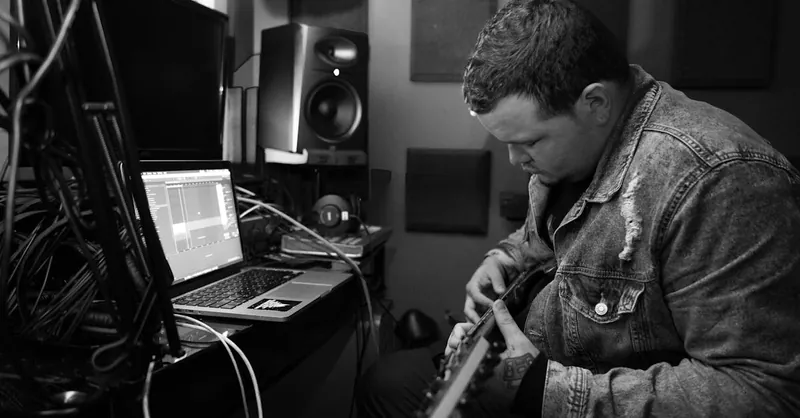
Image courtesy of Brett Sayles
DAW #1: Ableton Live – Strengths in Live Looping, Guitar-Friendly Plugins, and Workflow Tips for Guitarists
Ableton Live stands out as a powerhouse DAW for guitarists who prioritize live performance, looping, and a dynamic workflow that adapts to both studio recording and on-stage use. Its session view is particularly tailored for creating loops and layering guitar parts in real time, making it a favorite among modern guitarists exploring experimental and ambient soundscapes or intricate layering techniques. Whether you're tracking a single riff or building multi-layered live arrangements, Ableton’s non-linear clip-based environment facilitates spontaneous creativity without interrupting your flow.
Another key strength of Ableton Live is its seamless integration with guitar-friendly plugins and amp simulators. It supports popular VSTs such as Amplitube, Guitar Rig, and Bias FX natively, providing guitarists immediate access to a vast palette of tones—from vintage tube amps to high-gain modern rigs. Ableton’s native effects, like the Amp, Cabinet, and Pedal devices, are also surprisingly flexible and lightweight on CPU, allowing smooth real-time monitoring with minimal latency—crucial for recording electric guitar. The able ability to map hardware controllers directly to effects parameters enhances expressive control over pedals and amp settings during tracking or live sets.
Workflow tips for guitarists using Ableton Live:
- Use the Session View for Looping and Layering: Record riffs into clips and arrange them on the fly, experimenting with dynamics and textures without needing to stop playback.
- Leverage Ableton’s MIDI and Audio Freeze: Quickly free up CPU by freezing tracks with complex amp sims or effects chains, enabling larger track counts in sessions with multiple guitar layers.
- Customize Effect Racks for Instant Tone Switching: Chain multiple guitar effects into a Rack and assign macros to knobs for seamless transition between clean tones, overdrives, and modulations during performance or mixing.
For guitarists seeking a DAW that bridges creative live looping, powerful guitar plugin support, and an intuitive, fast workflow, Ableton Live is an exceptional choice. Its ability to blend studio-quality recording with forward-thinking live session capabilities makes it uniquely versatile among guitar-centric DAWs.
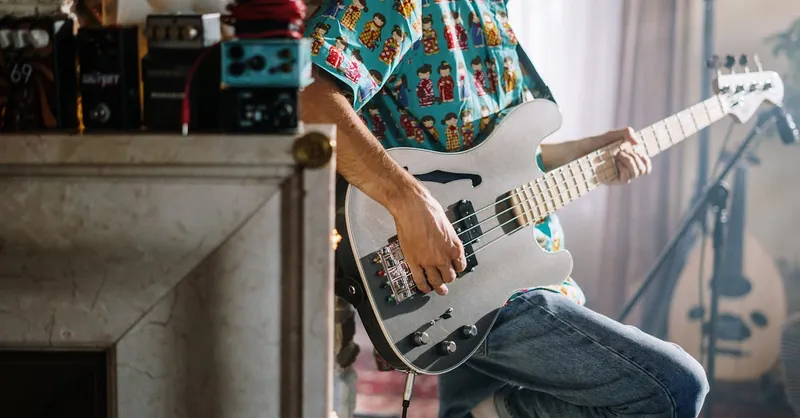
Image courtesy of cottonbro studio
DAW #2: Logic Pro X – Deep Guitar Amp Sims, Seamless macOS Integration, and Comprehensive Production Tools
Logic Pro X is a standout choice for guitarists who use macOS, offering exceptional built-in amp simulations and effects that capture authentic guitar tones without the need for heavy third-party plugins. Its Amp Designer and Pedalboard provide highly customizable guitar rigs, emulating classic and modern amplifiers, cabinets, and stompboxes with remarkable detail and clarity. This means you can craft rich, organic guitar sounds directly within the DAW, perfect for both tracking and mixing stages, while maintaining low latency performance essential for expressive playing.
Beyond amp simulations, Logic Pro X boasts a comprehensive suite of production tools tailored for guitarists—including advanced comping, flexible track stacking, and powerful audio editing features. Its drum machines, virtual instruments, and MIDI capabilities allow guitarists to easily experiment with arrangements, layer harmonies, and integrate virtual gear for hybrid compositions. The seamless integration with macOS ecosystems ensures optimized performance, smooth hardware compatibility, and intuitive workflows—whether you’re recording in a professional studio or working on home productions.
Key Features That Make Logic Pro X Ideal for Guitarists
- Deep Amp Designer with Multi-Channel Cabinet IRs: Offers great tonal flexibility and realism for clean, crunchy, or high-gain sounds.
- Extensive Pedalboard Effects: Includes drives, modulation, delay, and reverb pedals designed to replicate classic analog gear.
- Seamless macOS Integration: Efficient CPU usage, native support for Apple Silicon chips, and smooth AU plugin management ensure stability and speed.
- Comprehensive Mixing and Editing Tools: Smart Tempo, Flex Time audio editing, and track comping streamline capturing perfect guitar takes.
- Intuitive Interface with Track Stacks: Easily organize multi-mic recording setups or layered guitar parts with clean visual grouping and routing options.
Logic Pro X’s robust guitar amp simulations combined with powerful production workflows make it ideal for guitar players who demand a professional-grade, all-in-one DAW on Apple hardware. Whether you’re shaping intricate solo tones, building lush soundscapes, or composing full productions, Logic Pro X delivers the tools and flexibility required to bring your guitar music to life at every stage.
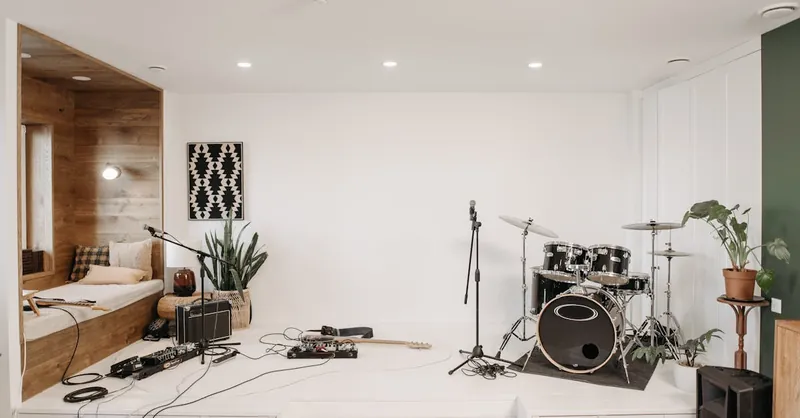
Image courtesy of Pavel Danilyuk
DAW #3: Pro Tools – Industry-Standard Recording, Editing Precision, and Compatibility with Pro Guitar Hardware
Pro Tools remains the gold standard in professional music production studios worldwide, making it an exceptional DAW choice for guitarists who demand top-tier recording quality, meticulous editing tools, and seamless hardware integration. Known for its rock-solid audio engine and low-latency monitoring, Pro Tools enables guitar players to capture every nuance of their performance with industry-grade clarity—whether you're tracking pristine clean tones or heavy distorted riffs.
One of Pro Tools' standout features is its unmatched editing precision, which lets guitarists fine-tune timing, dynamics, and articulation at a micro-level using powerful tools like Elastic Audio and Beat Detective. This is especially valuable when working with complex guitar parts or punchy rhythm tracks that need perfect alignment and groove. Furthermore, Pro Tools boasts extensive compatibility with professional guitar recording hardware, such as high-end audio interfaces, preamps, and DSP-powered effects units, ensuring ultra-low latency signal flow and superior tone fidelity.
Why Pro Tools is Perfect for Guitar Music Production
- Industry-Standard Audio Recording and Processing: Trusted by top studios for capturing guitar tracks with uncompromising sound quality and depth.
- Advanced Editing and Comping Features: Elastic Audio allows tempo-flexible editing without sacrificing audio integrity, perfect for tightening multi-take guitar performances.
- Seamless Integration with Pro-Level Gear: Supports hardware like Avid HDX systems, Universal Audio interfaces, and other premium guitar preamps and processors.
- Robust Plugin Ecosystem: Compatible with nearly every popular guitar amp simulator, effects plugin, and virtual instrument, expanding creative possibilities.
- Scalable Workflow: Whether you’re tracking a solo or working on a full band mix, Pro Tools provides scalable session management for complex multi-track guitar arrangements.
For guitarists seeking professional studio-grade recording software that excels in detailed editing, stable performance, and hardware compatibility, Pro Tools delivers a dependable platform that enhances every stage of guitar music production. Its pervasive industry presence also means learning Pro Tools can open doors to studio collaborations and professional projects, making it an invaluable tool for serious guitarists looking to elevate their production quality.
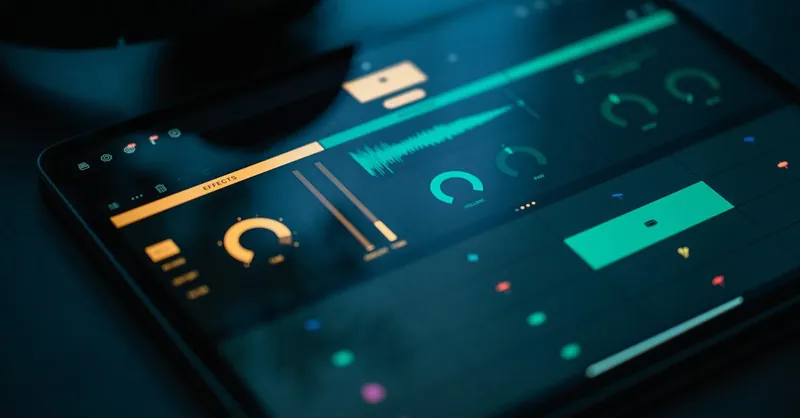
Image courtesy of Egor Komarov
DAW #4: Reaper – Highly Customizable, Lightweight, Affordable, and Great Routing Options for Guitar Effects
Reaper stands out as a flexible and lightweight DAW that appeals to guitarists who want a fully customizable production environment without the bloat of more resource-heavy software. One of Reaper’s biggest advantages is its affordability combined with pro-level features, making it accessible to guitarists at all levels who want an efficient, powerful recording and mixing platform. Unlike many DAWs with steep learning curves and hefty system demands, Reaper boasts an optimized audio engine that runs smoothly even on modest setups—ideal for guitar players recording at home or on the go.
What truly makes Reaper a favorite among guitarists is its exceptional routing capabilities and plugin hosting versatility. You can create intricate effect chains with ease, sending guitar signals through virtual amp simulators, cabinet emulators, delay lines, modulation effects, and more on individual tracks or buses. This flexibility allows guitarists to experiment freely with tone shaping, layering, and parallel processing techniques. Additionally, Reaper supports virtually all major plugin formats (VST, AU, JSFX), including popular guitar-centric amps and stompboxes, so you’re never limited in creating your signature sound.
Why Guitarists Choose Reaper for Music Production:
- Highly Customizable Interface – Tailor layouts, menus, and toolbars to suit your guitar workflow for faster navigation and editing.
- Lightweight and Resource-Efficient – Optimized performance enables stable low-latency guitar tracking with complex amp sims even on lower-end systems.
- Advanced Routing and Bussing – Build complex guitar effects chains, send signals to multiple effect chains simultaneously, or use parallel processing for dynamic tone control.
- Affordable Licensing Model – Offers a full-featured evaluation period and a cost-effective license, making it perfect for budget-conscious guitar players.
- Strong Community and Script Support – Access user-created extensions and scripts tailored for guitar production, from custom metering tools to workflow enhancers.
Reaper’s blend of affordability, deep customization, and powerful routing for guitar effects makes it an excellent choice for guitarists who demand both professional sound quality and maximum control over their tone. Whether you’re crafting detailed multi-layered guitar tracks or exploring complex effects combinations, Reaper’s adaptability ensures it can grow with your skills and creative ambitions.
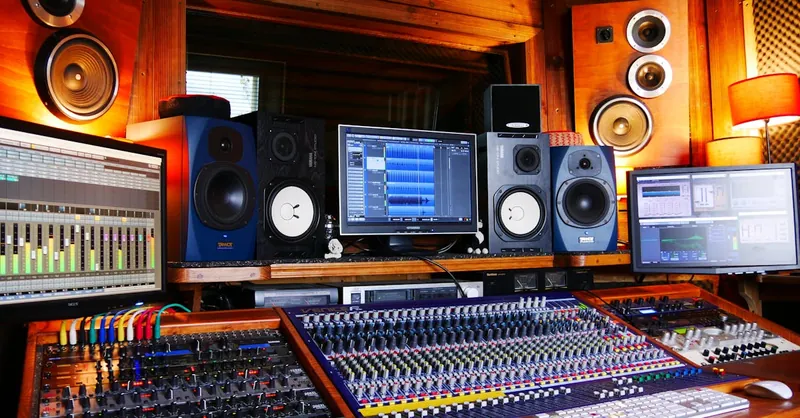
Image courtesy of Tom de Monteiller
DAW #5: Cubase – Advanced Guitar Tracking Features, Chord Tools, and Native Guitar Effects Plugins
Cubase rounds out our list as a powerful DAW tailored for guitarists who demand professional-grade guitar tracking, sophisticated chord tools, and high-quality native effects. Developed by Steinberg, Cubase has long been revered for its deep audio editing capabilities coupled with musician-friendly features that specifically address the nuances of guitar performance and production. Whether you’re recording complex lead lines, layering rhythm parts, or composing full arrangements, Cubase offers intuitive tools that significantly streamline the workflow for guitar players.
One of Cubase’s standout strengths lies in its advanced guitar tracking features that minimize latency and preserve the original guitar tone during recording. Its low-latency monitoring engine ensures that what you hear through your studio monitors or headphones matches your performance in real time, critical for expressive playing and tight timing. Coupled with this, Cubase includes the Chord Track and Chord Assistant, which intelligently analyze and suggest chord progressions, enabling guitarists to experiment with harmonies or quickly lay down backing tracks without extensive music theory knowledge. This is ideal for crafting rich, evolving song structures and working on complex rhythm parts.
Moreover, Cubase boasts a wide range of native guitar effects plugins including amp simulators, distortion pedals, modulation effects, and reverbs designed with guitar tone sculpting in mind. These built-in plugins are not only optimized for low CPU usage but also offer flexible routing options, allowing guitarists to build intricate signal chains and fine-tune their tone without relying solely on third-party software. Cubase’s VariAudio pitch correction and timing tools further empower guitarists to polish performances and perfect intonation with surgical precision.
Key Guitar-Oriented Features in Cubase:
- Low-Latency Monitoring Engine – Enables real-time performance capture with zero audible delay, preserving natural feel and timing.
- Chord Track and Chord Assistant – Powerful tools for automatic chord detection, progression suggestions, and harmonic experimentation.
- Comprehensive Native Effects Suite – Includes guitar amp simulators, distortion, modulation, delay, and ambience effects tailored to guitar tones.
- Flexible Signal Routing and Track Presets – Easily save and recall guitar effect chains and setups for consistent tone across projects.
- VariAudio Pitch and Timing Correction – Perfect for editing intricate guitar solos or harmonized parts for flawless playback.
For guitarists seeking a DAW that combines professional tracking precision, sophisticated chord generation tools, and versatile native guitar effects, Cubase offers a complete production environment that nurtures creativity without sacrificing technical accuracy. Its rich feature set makes it a compelling choice for guitar players aiming to elevate their recording and mixing workflow while exploring new harmonic territories.
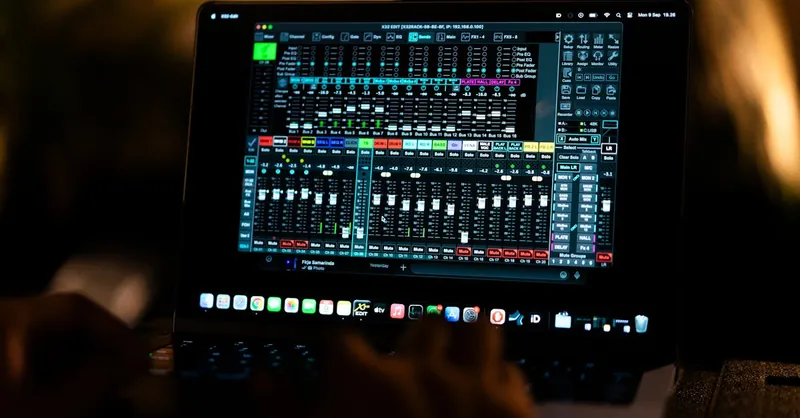
Image courtesy of gabriel bodhi
Comparing Key Features Among Top Guitar DAWs – UI, Plugins, Guitar Amp Sims, MIDI Support, and Price
Choosing the right DAW as a guitarist hinges on carefully weighing features that directly impact your tone crafting, workflow, and budget. Each of the top five guitar DAWs excels in different areas—understanding these distinctions can help you select the perfect software to complement your playing style and production needs.
User Interface (UI) and Workflow
A guitar-friendly UI is essential for maintaining creative momentum during recording and mixing.
- Ableton Live offers a highly visual, clip-based Session View optimized for live looping and fast experimentation, ideal for guitarists who rely on layering and improvisation.
- Logic Pro X and Cubase prioritize a more traditional linear timeline layout but pair it with intuitive track stacking, detailed comping, and integrated chord tools, suited for detailed multi-layer tracking and composition.
- Pro Tools features a sleek, minimalist interface tailored to precision editing and professional session management, perfect in studio environments requiring complex multi-track arrangements.
- Reaper stands out for its customizable interface that guitarists can tailor, enhancing navigation speed and usability unique to individual workflows.
Plugins and Built-In Guitar Amp Simulators
Plugin compatibility and native guitar amp simulations define the tonal palette available within a DAW:
- Logic Pro X’s Amp Designer and Pedalboard provide deep, authentic amp and pedal simulations without extra cost, enabling guitarists to dial tones easily within the session.
- Cubase includes comprehensive native guitar effects optimized for low CPU usage, from amps to modulation, balanced with flexible routing to create complex soundscapes.
- Ableton Live relies more heavily on seamless integration with third-party VSTs like Amplitube and Guitar Rig while offering lightweight native amp devices for quick tone shaping.
- Pro Tools boasts vast plugin support, including industry-standard guitar amp sims, but native guitar effects are more limited, often encouraging external plugin usage for tone sculpting.
- Reaper supports nearly every third-party format available, making it a powerhouse for guitarists wanting to experiment freely with any amp sim or effect, combined with its excellent routing for effect chains.
MIDI Support and Hybrid Guitar Integration
For guitarists exploring MIDI control or guitar-to-MIDI conversion, efficient hybrid audio-MIDI support expands sonic possibilities:
- Ableton Live excels with its robust MIDI routing and integration, perfect for guitarists triggering loops or controlling synths alongside guitar parts.
- Logic Pro X features advanced MIDI editing, smart tempo, and virtual instruments, encouraging hybrid guitar and keyboard setups.
- Cubase shines with its MIDI chord tools and harmony assistants, designed to help guitarists compose and experiment with chord progressions on the fly.
- Reaper offers flexible MIDI routing and scripting that power users can harness to customize their MIDI workflows extensively.
- Pro Tools supports professional MIDI sequencing but is often preferred for its audio recording prowess, with MIDI functionality more standard than specialized for guitarists.
Price and Value for Guitarists
Pricing often influences choice, especially for hobbyists or those building home studios:
- Reaper is the most cost-effective, offering a full-featured license at a fraction of other DAWs, making it highly attractive for budget-conscious guitarists.
- Ableton Live and Cubase fall into mid-to-high price ranges, balanced with professional-grade features and excellent plugin suites tailored to guitar applications.
- Logic Pro X remains exceptional value considering its deep native amp sims, effects, and macOS optimization—offering a one-time purchase with frequent free updates.
- Pro Tools typically carries the highest cost, particularly for its premium HD versions and hardware integration, suiting guitarists working in professional studios or requiring top-tier processing capabilities.
By comparing these critical areas—user interface design, plugin and amp sim quality, MIDI capabilities, and pricing—guitarists can make an informed decision. Align your priorities, whether it’s streamlined live looping, deep amp simulation, extensive editing power, or budget-friendly flexibility, to choose a DAW that amplifies your guitar music production to the next level.
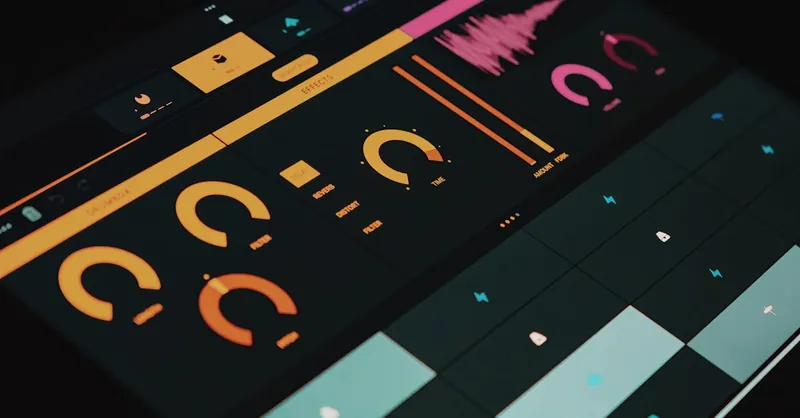
Image courtesy of Egor Komarov
How to Choose the Right DAW Based on Your Guitar Playing Style and Production Needs
Selecting the perfect DAW to complement your guitar playing style and production workflow is crucial for unlocking your creative potential and achieving the best possible tone. Different guitarists have unique priorities—whether it’s razor-sharp editing for precise solos, flexible live looping for experimental layering, or immersive amp simulations for authentic tone crafting—and your DAW choice should align with these priorities to enhance productivity and inspiration.
Consider Your Guitar Playing Style
-
Lead Guitarists and Soloists: If you focus on intricate solos or expressive lead lines, prioritize DAWs with advanced comping tools, pitch correction, and detailed editing features. Logic Pro X, Cubase, and Pro Tools excel here, offering precision editing and flexible tuning tools to refine your performances flawlessly.
-
Rhythm Guitarists and Songwriters: For those building songs with layered rhythm parts and chord progressions, DAWs featuring chord assistive tools, easy arrangement workflows, and track stacking become vital. Cubase’s Chord Track and Logic Pro X’s Smart Harmony functions empower guitarists to experiment with complex harmonies and song structures quickly.
-
Experimental and Loop-Based Guitarists: Guitarists exploring live looping, ambient layers, and on-the-fly arrangement benefit from DAWs emphasizing non-linear clip launching and MIDI integration. Ableton Live reigns supreme in this category, allowing seamless capturing and manipulation of loops with minimal workflow interruption.
Match Your Production Needs and Gear Integration
-
If you use hardware guitar rigs or professional audio interfaces, DAWs like Pro Tools provide unmatched hardware compatibility and low-latency monitoring, ensuring the purest signal path from guitar to session.
-
For guitarists relying heavily on native amp simulators and built-in effects, Logic Pro X and Cubase offer rich, CPU-efficient tone-shaping tools without needing extra plugins, streamlining your setup and saving processing power.
-
Budget-conscious players and home studio owners who want exceptional flexibility without breaking the bank will find Reaper's customizable environment and affordable licensing model hard to beat.
-
If your workflow involves tight integration of MIDI controllers or guitar-to-MIDI converters alongside guitar tracks, Ableton Live and Cubase provide advanced hybrid audio-MIDI support to expand your sonic palette and streamline production.
Final Tips for Choosing Your Guitar DAW
- Test trial versions whenever possible to gauge how the DAW feels with your specific gear and playing style.
- Prioritize DAWs with intuitive interfaces that minimize technical distractions during the creative process.
- Consider the learning curve and available community resources to ensure long-term support and growth.
By evaluating your personal guitar techniques, stylistic goals, and gear setup against each DAW’s strengths, you can confidently select the ideal Digital Audio Workstation that will inspire your guitar performances and elevate your productions to professional levels.
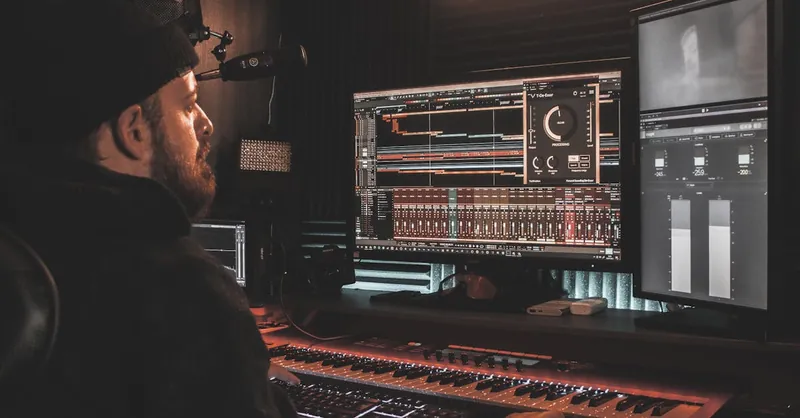
Image courtesy of Techivation
Tips for Optimizing Your DAW Setup for Guitar Recording and Effects Processing
Getting the most out of your DAW for guitar music production goes beyond just choosing the right software—it’s about fine-tuning your setup to capture your guitar tone authentically and streamline your creative workflow. Optimizing your DAW environment ensures low latency, crisp signal quality, and flexible effects routing, all of which are essential for recording expressive guitar performances and crafting unique sounds with pedals, amp sims, and multi-effect chains.
Essential Optimization Strategies for Guitarists
-
Prioritize Low-Latency Monitoring
Configure your audio interface’s buffer size to the lowest stable setting to reduce delays between playing your guitar and hearing the processed sound. Most DAWs allow dedicated low-latency monitoring modes—enabling these prevents distracting lag and preserves playing feel, especially when tracking through complex amp simulators and effect chains. -
Create Custom Track Templates for Guitar Recording
Save time and maintain consistency by building tailored track templates preloaded with your preferred amp sims, EQ settings, and basic effects like compression or noise gates. This approach speeds workflow during recording sessions and ensures your guitar tone starts on a solid foundation. -
Leverage Flexible Signal Routing and Bussing
Use your DAW’s routing features to create parallel effect chains and send your guitar signal to multiple effects buses simultaneously—such as blending a dry DI signal with wet amp simulations or running separate delay and reverb buses for greater tonal depth. This flexibility enhances creative control without cluttering your mix. -
Use Plugin Freeze and Track Bouncing
High-quality amp sims and effects can be CPU-intensive. To maintain smooth performance, utilize plugin freeze or track bouncing after finalizing your tone. This reduces processing load without compromising audio quality, allowing you to run larger, more complex sessions with multiple guitar layers. -
Integrate Hardware Controllers for Hands-On Control
Mapping MIDI controllers or foot pedals directly to your DAW’s guitar effects and amp parameters provides expressive real-time manipulation during both recording and mixing. This tactile control empowers dynamic tone shaping and can inspire new playing approaches. -
Organize Your Session with Clear Track Naming and Color Coding
When working with multiple guitar takes, layers, and effects chains, a clean session layout is critical. Use consistent naming conventions, color coding, and folder tracks to navigate your project efficiently and focus on creativity instead of managing clutter.
By implementing these DAW optimization tips specifically aimed at guitar recording and effects processing, guitarists can achieve faster workflows, richer tone sculpting, and a more immersive recording experience. An optimized DAW setup not only preserves the nuances of your guitar playing but also unlocks the limitless potential of modern music production.
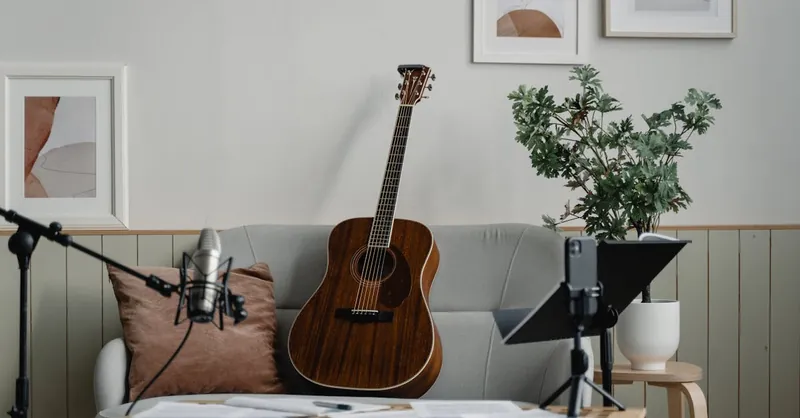
Image courtesy of Tima Miroshnichenko
Integrating External Guitar Gear with Your DAW – Interfaces, Effects Pedals, and Amp Simulation
For guitarists serious about crafting authentic tones and expanding creative possibilities, integrating external guitar gear seamlessly with your DAW is a critical component of a professional music production setup. Whether you utilize high-quality audio interfaces, classic stompboxes, multi-effects units, or amp simulators, the ability to connect and control your hardware and software tools within your DAW environment ensures maximum tonal flexibility and workflow efficiency.
Audio Interfaces Designed for Guitar Recording
A dedicated guitar audio interface acts as the essential bridge between your instrument and your DAW, delivering low-latency, high-fidelity capture of your playing dynamics. Features to look for include:
- Instrument-Level (Hi-Z) Inputs – These inputs are optimized for electric and bass guitars, preserving the signal’s integrity without tonal coloration or unwanted noise.
- Low-Latency Monitoring – Enables real-time monitoring of your guitar through your DAW’s amp simulators or external gear, crucial for expressive playing and accurate tone shaping.
- Multiple Channels and I/O Routing – Facilitates simultaneous recording of guitar rigs with mic’d amps, DI signals, and external effects, allowing you to blend and re-amp tracks during mixing.
- Compatibility and Driver Stability – Ensure your interface supports the sample rates and bit depths preferred by your DAW and offers stable ASIO or Core Audio drivers for smooth operation.
Well-regarded interfaces like the Universal Audio Apollo Twin, Focusrite Scarlett series, and IK Multimedia’s iRig Pro are popular among guitarists for their premium audio quality and seamless DAW integration.
Using Effects Pedals and Multi-Effect Units with Your DAW
Incorporating external effects pedals or multi-effect processors adds rich analog character and tactile control that software alone can’t fully replicate. There are two primary approaches to integrating pedals with your DAW:
-
Recording Dry DI Signals and Re-amping
Capture your guitar’s clean DI (direct input) signal through your interface, then later route the recorded track back out to your pedals and amplifier or re-amp box. This method offers unparalleled tone flexibility, letting you experiment with pedal settings and amp tones during mixing without committing to a sound during tracking. -
Real-Time Processing via Effects Loop or Insert
Connect pedals directly into your guitar rig’s effects loop or via an insert on your audio interface, then monitor the processed sound live. This enables immediate interaction and performance dynamics, ideal for capturing the energy of on-the-fly pedal manipulation during tracking or live sessions.
When integrating pedals, using high-quality cables, proper gain staging, and buffer pedals can optimize signal integrity and prevent tone degradation.
Leveraging Amp Simulation within Your DAW
Modern amp simulation plugins have transformed guitar recording by providing realistic amp tones and speaker cabinet emulations directly inside your DAW. Utilizing amp sims offers several key benefits:
- Instant Access to Diverse Guitar Tones: Dial in countless amp styles—from vintage clean to heavy distortion—without multiple physical amplifiers.
- Flexible Signal Routing and Preset Management: Save complex tone chains, switch presets instantly, and automate amp parameters to suit different sections of your song.
- CPU-Friendly Options and Low Latency: Many native amp sims are optimized to minimize CPU load and latency, facilitating smooth tracking and mixing without hardware investment.
Most of the top guitar DAWs reviewed here support popular amp sims like Amplitube, Guitar Rig, Bias FX, and Logic’s Amp Designer, allowing you to blend external gear and virtual amps for hybrid tones that leverage the best of both worlds.
In summary, integrating your external guitar gear—audio interfaces, pedals, and amp simulators—with your DAW not only elevates the sonic quality of your recordings but also enhances your creative workflow. Whether you prefer the tactile feel of analog pedals, the convenience of re-amping, or the versatility of software amps, mastering these integrations is essential for any guitarist striving to produce professional, expressive guitar music in today's digital production landscape.

Image courtesy of Alexey Demidov
Future Trends in Guitar-Focused DAWs and What Guitarists Should Watch For
As music production technology evolves, guitarists can expect significant advancements in Digital Audio Workstations (DAWs) that cater specifically to guitar playing and tone crafting. Staying ahead of these future trends will empower guitar players to leverage cutting-edge tools, streamline workflows, and push the boundaries of creativity. Here are some key developments to watch for in guitar-focused DAWs:
1. Enhanced Artificial Intelligence (AI) and Machine Learning Integration
AI-driven features will increasingly assist guitarists in performance editing, tone matching, and songwriting. Expect intelligent comping tools that can automatically select the best guitar takes, smart pitch correction tailored for guitar nuances, and AI-powered amp sim presets that analyze your playing style and adapt tones dynamically. These innovations will save time while maintaining the natural expression and feel essential to guitar performances.
2. Native Support for Guitar-to-MIDI and Extended Hybrid Workflows
As guitarists continue blending traditional playing with MIDI control, DAWs are enhancing native guitar-to-MIDI conversion accuracy and offering deeper integration of hybrid audio-MIDI setups. Future updates will likely improve latency, tracking precision, and expressive control parameters, allowing for seamless use of MIDI synths, drum triggers, and virtual instruments alongside guitar tracks within the same session. This expands sonic possibilities and creative experimentation for modern guitarists.
3. Advanced Real-Time Collaboration Features and Cloud Integration
With remote collaboration becoming the norm, guitar-focused DAWs will incorporate real-time session sharing, cloud-based project management, and seamless plugin compatibility across devices. Guitarists will benefit from instantly syncing multi-track sessions with bandmates or producers, enabling faster feedback loops and co-creation without geographical boundaries. This trend will make professional-level guitar production accessible from home studios and mobile setups.
4. Improved Hardware Integration and Smart Effects Automation
Future DAWs will likely offer tighter integration with smart guitar hardware, multi-effects controllers, and amp modeling devices. Expect more intuitive automation of pedal parameters, amp channel switching, and expression control directly within the DAW environment, synchronized with your playing. This synergy between software and external gear enables expressive performance capture and dynamic tone manipulation in both live and studio contexts.
5. Immersive Audio and Spatial Effects Tailored for Guitarists
As immersive audio formats gain popularity, guitar DAWs will enhance native support for 3D audio, surround sound mixing, and spatial effects designed to position guitar tones in a multidimensional soundstage. This technology will give guitarists new tools to craft expansive sonic landscapes, from live concert simulations to cinematic scoring, enriching the listener’s experience and opening fresh creative avenues.
For guitarists aiming to stay competitive and inspired in music production, keeping abreast of these future DAW trends is essential. Choosing a DAW with a strong roadmap toward AI integration, hybrid MIDI/audio workflows, cloud collaboration, hardware synergy, and immersive audio capabilities will ensure your guitar productions remain cutting-edge and creatively fulfilling in the years to come.

Image courtesy of Brett Sayles
